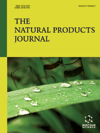- Home
- A-Z Publications
- Natural Products Journal, The
- Previous Issues
- Volume 7, Issue 2, 2017
Natural Products Journal, The - Volume 7, Issue 2, 2017
Volume 7, Issue 2, 2017
-
-
Future Leads: Natural Products as Anti-infective Agent
More LessAuthors: Manisha Gautam, Debabrata Acharya, Zulfiqar Ali Bhat and Dinesh KumarNatural drugs have become a subject of world importance with both therapeutic and economic implications. Natural products are harnessed as potential therapeutic candidates from natural resources for the discovery of lead drug candidates and new pharmaceutical products. The natural products provide most of the FDA approved formulations. Thus, they are the continuous source of inspiration in the development of new Read More
-
-
-
Phytochemistry, Traditional Uses and Bioactivity of the Medicinal Plant Schinus areira L. (Anacardiaceae): A Review
More LessAuthors: Ana Paula Murray and Maria Gabriela MurraySchinus areira L. (syn. Schinus molle L. var. areira (L.) DC.) belongs to the Anacardiaceae family, native to South America, now widely distributed in temperate zones of the world, known as “aguaribay”, “árbol de la pimienta”, “pepper tree”, “terebinto” or “pimentero”. It is considered a medicinal plant in the folk medicine and it is also appreciated by its culinary properties. Its fruits are used as a spice and to prepare a popular drin Read More
-
-
-
Biotechnological Induction of Shikimate-based Antioxidant Accumulation in Phyla dulcis
More LessBackground: Medicinal phytochemicals have been used as dietary supplements in Asia and Africa for thousands of years. Biologically active antioxidants are very diverse and low in their chemical compositions thereby limiting their efficacies. The present study focuses on the enhanced accumulation of closely related dietary antioxidants: shikimate, quinate, salicylate and tocopherol in Phyla dulcis, the Central American h Read More
-
-
-
Production of Indole-3-Acetic Acid by Cyanobacterial Strains
More LessAuthors: Nazia Ahmad and Tasneem FatmaBackground: Indole-3-Acetic Acid (IAA) is a plant hormone with various applications in the field of agriculture, medicine and research. Objective: We herein examined the production of IAA from various cyanobacterial strains. Method: During the present work, 34 cyanobacterial strains were screened to check their ability toexcrete IAA. Culture conditions of the strain producing maximum IAA content under normal conditions, Read More
-
-
-
Inhibitory Action of Forskolin and Its Semi-synthetic Analogues on Cyclooxygenase-2 Enzyme Activity: In silico and In vitro Studies
More LessAuthors: Deepika Godugu, Karuna Rupula and Beedu S. RaoBackground: Forskolin, a polyhydroxylated labdone diterpene extracted from Coleus forskohlii possesses various medicinal properties and has been used in the treatment of number of chronic diseases, in humans. Objectives: The effects of forskolin and its analogues (1a-1f) on COX-2 enzyme activity were evaluated (in silico and in vitro studies). Materials and Methods: Forskolin and its analogues (1a-1f) were evaluated for their Read More
-
-
-
A Comparative Evaluation of In-Vitro Antioxidant Activity of Some Commonly Used Spices of Northern India
More LessAuthors: Paavan Singhal, Neha Singla, Dhanashree Sakhare and Anil K. SharmaBackground: Plants, including herbs and spices, have many phytochemicals which are a potential source of natural antioxidants e.g., phenolic diterpenes, flavonoids, alkaloids, tannins and phenolic acids. Various researches have been done to find out the relative antioxidant activities of various herbs, fruits, vegetables and spices. Objectives: Present study was carried out to evaluate the antioxidant status of five common Read More
-
-
-
Synthesis and Bio-evaluation of 7-trifluromethyl Substituted 4-aminoquinoline Derivatives as Antileishmanial Agents
More LessBackground: Visceral Leishmaniasis (VL) is a fatal disseminated protozoan infection. VL threatens 200 million people in 62 countries and responsible for 40,000 deaths each year. Chemotherapy is the only tool for the treatment of VL, but, as yet, none of the available drugs are ideal for treatment due to high toxicity, resistance issues and prohibitive prices. Hence, there is an urgent need for the development of new and safer drugs Read More
-
-
-
Antiplasmodial, Cytotoxicity and Phytochemical Constituents of Four Maytenus Species Used in Traditional Medicine in Kenya
More LessBackground: In Kenya, several species of the genus Maytenus are used in traditional medicine to treat many diseases including malaria. In this study, phytochemical constituents and extracts of Maytenus undata, M. putterlickioides, M. senegalensis and M. heterophylla were evaluated to determine compound/s responsible for antimalarial activity. Objective: To isolate antiplasmodial compounds from these plant species whi Read More
-
-
-
Characterization of NaCl-tolerant Mutant Strain of the Cyanobacterium Spirulina platensis Overproducing Phycocyanin
More LessAuthors: Apurva Gupta and Surendra SinghBackground: Spirulina spp., a promising source of phycocyanin, is commercially grown in open ponds and raceways photoautotrophically. However, the economic exploitation in an open system seems to have been limited because of lack of multiple stress-tolerant strains. Methods: In order to have an improved production of phycocyanin, a NaCl tolerant mutant of the cyanobacterium Spirulina platensis was isolated using a che Read More
-
Most Read This Month
Article
content/journals/npj
Journal
10
5
false
en


